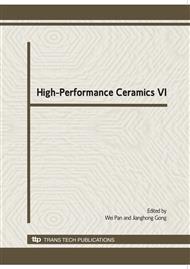p.224
p.228
p.231
p.235
p.240
p.244
p.247
p.253
p.256
Magnetic Properties of Manganese-Titanium Substituted Barium Ferrite Ba(TiMn)xFe12-2xO19(x=0.0, 0.5, 1.0, 1.5, 2.0) Prepared by the Molten Salt Method
Abstract:
M-type hexaferrites Ba(TiMn)xFe12-2xO19 (x=0 to 2) powders were synthesized by molten salt method. X-ray diffraction, scanning electron microscope and vibrating sample magnetometer were used to analyze the structures and electromagnetic properties. The results showed that, the magnetoplumbite structures for all samples were formed. Magnetic hysteresis loop measurements of the Ba(TiMn)xFe12-2xO19, exhibitted that the saturation magnetization (Ms), the remanent magnetization (Mr) and the coercitivity (Hc) of compounds depended strongly on the chemical composition of materials. The maxium values of Ms (52.68emu/g) and Mr (32.89emu/g) of the compounds were found at x=0.5; however, the values of Hc and the areas of magnetic hysteresis loop of compounds decreased with increasing the value of x. The Ba(TiMn)1.5Fe9O19/paraffin wax composites containing 40vol% of doped barium ferrite exhibitted good absorption performances in the frequency range of 2–14 GHz.
Info:
Periodical:
Pages:
240-243
Citation:
Online since:
March 2010
Authors:
Price:
Сopyright:
© 2010 Trans Tech Publications Ltd. All Rights Reserved
Share:
Citation:


